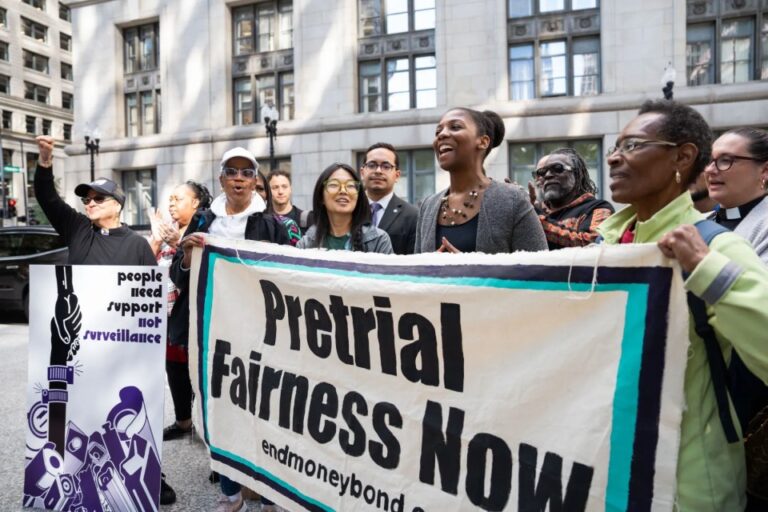Illinois becomes the first state in the nation today to completely remove cash bail as a condition to be released ahead of a criminal trial.
Here’s how the new system will work, and some of the questions still to be answered.
Who will not be jailed?
Under the new law, people who are charged with the state’s lowest level offenses will likely never set foot in a jail cell, including at a police station after their arrest.
People charged with an offense lower than a Class A misdemeanor — littering, some speeding charges and possession of marijuana over the legal limit — will likely be released with a citation and a court date without having to be processed at a police station.
In these cases, people usually face no more than six months in prison if convicted and often are released on probation without any incarceration.
However, law enforcement agencies will still be given discretion in certain cases. For example, if a person continues to commit the offense after being cited, they can be taken into custody and held until they appear before a judge, which must occur within 24 hours.
People can also be taken into custody if they can’t be properly identified, or if police believe a person poses a danger to the community or themselves. Police will have to explain their decision to hold the person.
What about more serious misdemeanors?
Class A misdemeanor offenses are slightly more serious, but still cover a lot of ground. They include shoplifting, simple battery, trespassing in a car or on property, possessing alcohol as a minor and street racing.
A person facing a Class A misdemeanor will be arrested and taken to a police station for booking, but should be released with a future court date instead of being taken to jail.
The first question for authorities is whether, under the law, the offense allows the judge to jail someone. For example, a judge can detain a person accused of domestic violence, even when the person is charged with a misdemeanor.
If the offense is not included on the list of detainable offenses, there is an expectation the person will be released without any conditions and given a date to appear in court. As with the lesser offenses, police agencies will still have leeway in deciding if a person poses a risk to the community or themselves if released.
If the offense is on the list of detainable charges, a person must be brought before a judge for an initial hearing within 24 hours. The accused has the right to make at least three calls within three hours to communicate with their family or an attorney. Police are required to post this information in a place where people who have been detained will see it and are required to document the calls or explain why no calls were made.
What about felony charges?
A person charged with a felony can face a year or more in prison if convicted, but many felony charges can also result in probation, meaning a person wouldn’t necessarily face jail time if convicted.
Under the law, many felonies are not detainable. These tend to be cases that don’t include allegations of violence, including gun possession without the proper permit.
If a case is not eligible for detention, a person might be released from the police station after booking. But they can also be held and brought before a judge within 24 hours.
At that hearing, a judge will decide the conditions under which a person will be released. Those can include a requirement that the defendant be placed on electronic monitoring, be subjected to a curfew or required to submit to drug testing.
Those conditions, including electronic monitoring, are subject to review and can be changed later. Judges are supposed to set the least restrictive conditions possible to ensure a person appears in court for hearings and doesn’t commit new crimes.
What’s the process for jailing someone?
If a felony charge is a detainable offense, it will be up to prosecutors to decide whether to ask a judge to hold the person in custody. If prosecutors don’t seek to detain the person, the person will be released with conditions the judge determines are necessary for compliance.
If a person is charged with a detainable offense — which includes murder, sex crimes and domestic battery and largely other crimes of violence — and prosecutors seek detention, the person will be brought before a judge within 24 hours for a detention hearing.
At that hearing, prosecutors and defense attorneys will make arguments to the judge. Prosecutors must provide clear and convincing evidence that a person poses a public safety or flight risk, which is a lower standard than the proof beyond a reasonable doubt to find someone guilty.
Prosecutors and defense attorneys can also ask for more time to hold the hearing and can be given a 24- to 48-hour extension. Defendants can also call witnesses to testify on their behalf, though a court can block someone from calling a complaining witness.
Victims will be given notice of the hearings by prosecutors and will get information on how to file an order of protection. If a person is released and violates an order of protection, prosecutors can file for detention and a judge can use that violation — as well as other violations of their conditions — to decide that the person should be detained.
Judges must make their findings in writing with an explanation of how they ruled, and are required to continue to find that the need for detention still exists at future hearings.

